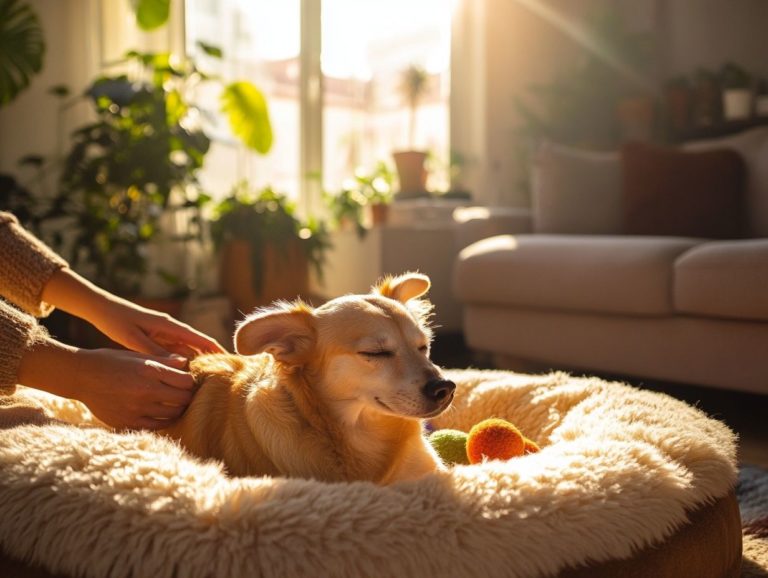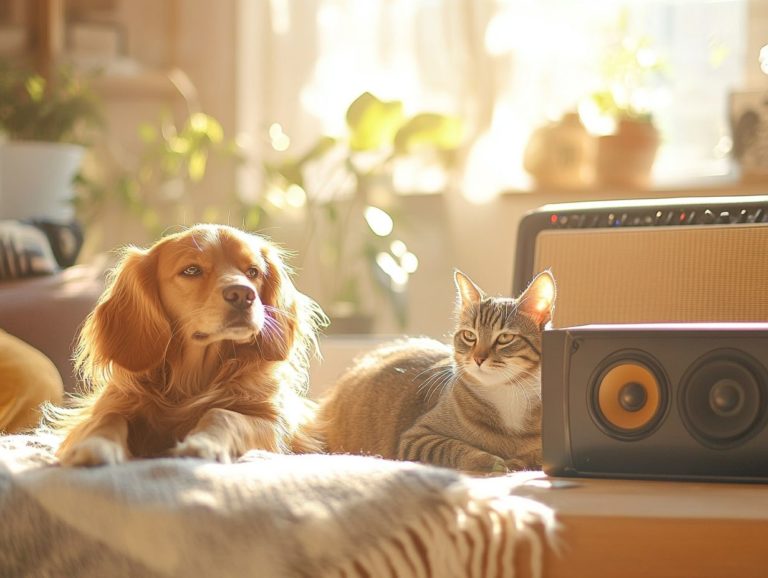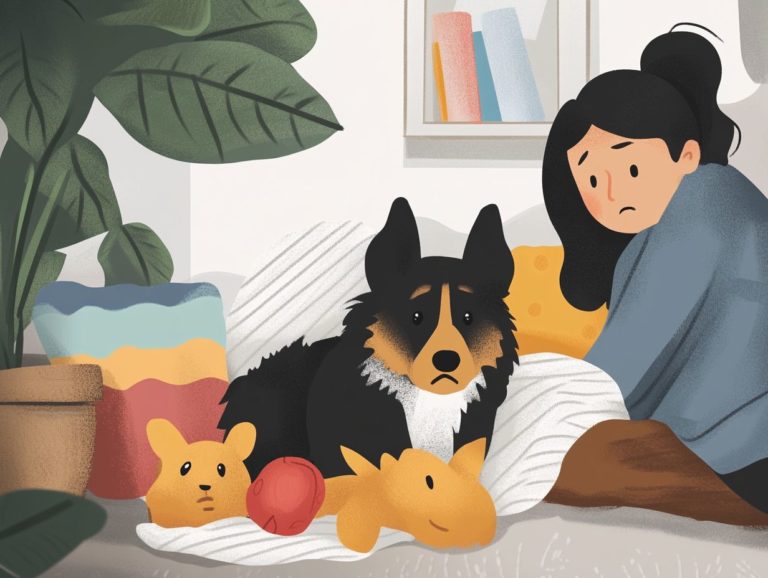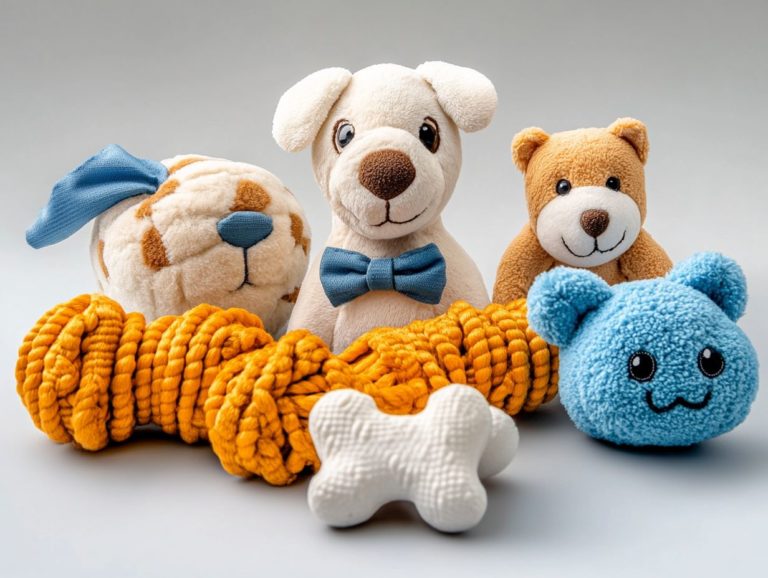Understanding Play Therapy for Anxious Pets
Anxiety in pets can reveal itself in various ways, from incessant barking to destructive behavior, often leaving you feeling powerless.
Play therapy has proven to be an effective approach for helping pets navigate their fears and stressors.
This article delves into the benefits of play therapy, highlights common signs of anxiety in pets, and outlines different types of play therapy tailored to your pet’s unique needs.
You ll find practical tips for establishing a play therapy routine, along with techniques to manage anxiety effectively.
In cases of severe anxiety, you’ll receive guidance on when it’s time to consult a professional.
Discover how engaging your pet in play can pave the way toward a calmer, happier existence for both you and your furry friend.
Contents
- Key Takeaways:
- Common Signs of Anxiety in Pets
- The Benefits of Play Therapy for Anxious Pets
- Ready to Help Your Furry Friend Feel Happier?
- Types of Play Therapy for Anxious Pets
- Creating a Play Therapy Routine for Your Pet
- Additional Techniques for Managing Pet Anxiety
- Consulting with a Professional for Severe Cases
- Frequently Asked Questions
- What is play therapy for anxious pets?
- How does play therapy benefit anxious pets?
- What types of activities are involved in play therapy for anxious pets?
- How do I know if my pet would benefit from play therapy?
- Is play therapy suitable for all types of pets?
- How can I find a qualified play therapist for my anxious pet?
Key Takeaways:
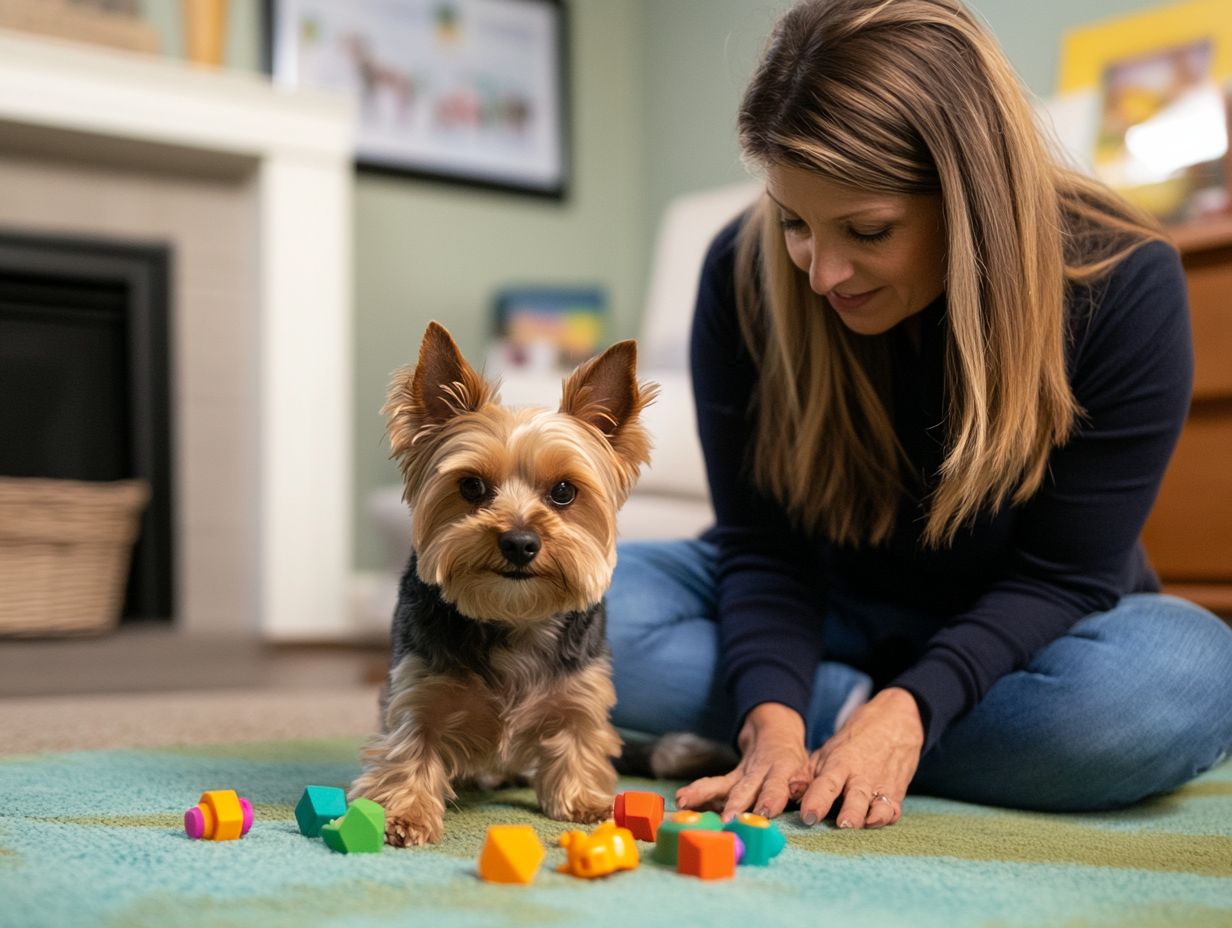
- Play therapy can help reduce anxiety in pets by providing a positive outlet for their energy and emotions.
- Common signs of anxiety in pets include destructive behavior, excessive barking or meowing, and changes in eating or grooming habits.
- Interactive play and solo play are both beneficial for anxious pets, but it’s important to find the right balance for your pet’s needs.
Common Signs of Anxiety in Pets
Recognizing the common signs of anxiety in pets, particularly in fearful dogs, is essential for effective intervention and enhancing their emotional well-being. You may notice these indicators manifesting both behaviorally and physically perhaps through excessive barking, destructive behavior, or even withdrawal and shifts in eating habits.
Understanding these symptoms not only helps you gauge the severity of your dog’s reactivity but also allows you to tailor appropriate anxiety treatment plans, ensuring that your canine companions receive the compassionate training they truly deserve.
The Benefits of Play Therapy for Anxious Pets
Play therapy has become an essential tool for enhancing the emotional well-being of anxious pets, especially dogs. This approach revolves around nurturing activities that strengthen the bond between humans and animals. By harnessing the dynamics of play and using positive reinforcement, you can facilitate meaningful behavioral change, helping fearful dogs find stress relief and relaxation. To learn more about this, check out the benefits of therapy for pets.
Through structured play therapy, you will witness a remarkable transformation in your canine companion. This method enriches their emotional landscape and allows you to engage in compassionate training that upholds safety assessments and management strategies. It s a rewarding journey that leads to a happier, healthier pet.
How Play Can Help with Anxiety
Engaging in play serves as a powerful anxiety treatment for your pets, providing them with an avenue to express themselves and forge emotional connections. To further enhance their well-being, understanding the role of a pet therapist can be beneficial. This interaction often leads to the release of a hormone that promotes bonding and happiness, enhancing their overall emotional support system.
Through various forms, like therapeutic and social play, these activities not only alleviate stress but also cultivate a sense of security and joy in your furry companions. For instance, therapeutic play might involve interactive toys crafted to challenge your pet’s mind, while social play typically encompasses group activities or visits to dog parks, where they can mingle with their peers.
By participating in training programs that focus on positive reinforcement such as clicker training or reward-based systems you further strengthen this bond, nurturing good behavior without resorting to intimidation. These methods have demonstrated effectiveness in reducing anxiety, enabling your pets to flourish in a supportive environment that promotes healthy interactions.
Ready to Help Your Furry Friend Feel Happier?
Let’s dive into how you can begin today!
Behavioral and Physical Indicators
Behavioral and physical indicators of anxiety in pets, especially in fearful dogs, can reveal critical insights into their emotional well-being.
You might notice excessive barking; this often signals distress or a plea for attention. Pacing is another telltale sign, indicating restlessness and an inability to settle.
Many dogs may retreat to corners or hide beneath furniture, clearly trying to escape perceived threats. If you observe trembling, it can be quite alarming, showcasing how profoundly anxiety can impact your pet.
A loss of appetite is a significant red flag. When a normally enthusiastic eater suddenly shows disinterest in their food, it’s important to know that something may be disturbing their peace.
Understanding these subtle nuances is crucial for effective anxiety treatment. This knowledge enables you to provide timely intervention and support for your furry companion.
Types of Play Therapy for Anxious Pets
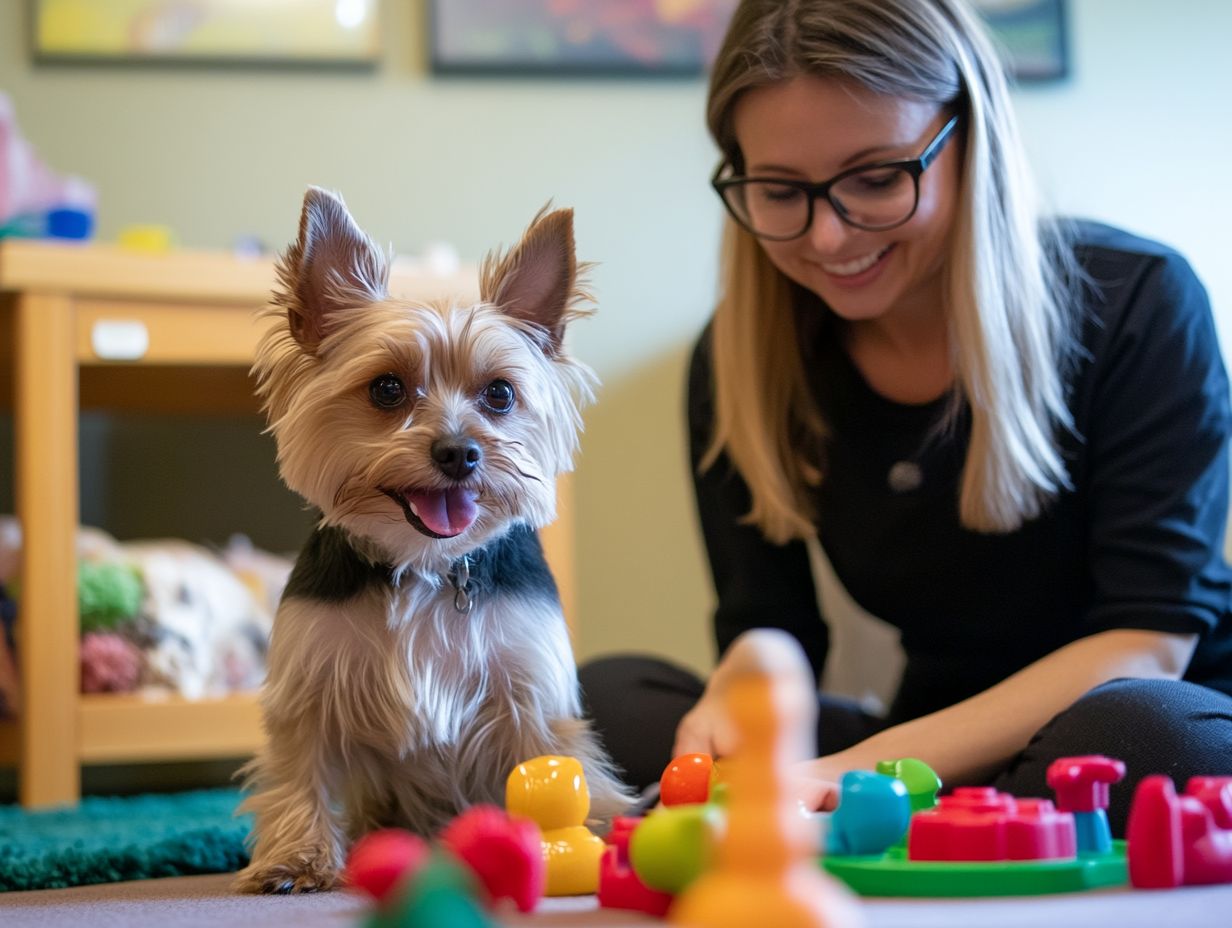
Explore various types of play therapy to alleviate anxiety in your pets by utilizing both interactive and solo play. Using games to alleviate pet anxiety can play a unique role in their emotional recovery and behavior change.
Interactive play fosters social connections and strengthens the bond between you and your pet. In contrast, solo play provides an opportunity for calming and relaxation.
These therapeutic approaches, rooted in animal therapy (which uses animals to improve mental health), can be customized to meet your companion’s individual needs, making them vital elements of a thorough anxiety treatment plan.
Interactive Play vs. Solo Play
Interactive play invites both you and your pet to engage actively. This strengthens your bond and enhances your dog’s emotional well-being through thoughtfully structured activities that promote mutual engagement.
This type of play not only cultivates a deep connection but also builds trust. This allows your pet to feel secure and understood in their environment.
On the other hand, solo play gives your furry friend the chance to explore independently, satisfying their innate instincts and promoting relaxation.
While interactive play fortifies your relationship, self-directed play also has its merits. It provides a valuable outlet for pent-up energy and relief from anxiety.
By combining both approaches, you can create a balanced routine that effectively manages anxiety and enhances your pet s overall mental health.
Creating a Play Therapy Routine for Your Pet
Establishing a play therapy routine for your pet requires thoughtful planning and consistency. Each session should include therapeutic play that specifically addresses your pet’s unique anxiety issues while fostering a calming environment, such as using aromatherapy to calm anxious pets.
A well-structured routine enhances the effectiveness of your dog training efforts. It also offers invaluable opportunities for relaxation exercises.
This careful method is crucial for their emotional support and helps change their behavior, paving the way for a more balanced and serene life for your furry companion.
Tips for Implementing Play Therapy
When you implement play therapy for your pets, several effective tips can enhance the experience and ensure successful emotional support. Start by using positive reinforcement to encourage desired behaviors during your sessions.
Select the right interactive toys that cater to your furry friend’s preferences; this keeps them engaged and mentally stimulated.
Creating a positive environment is equally important minimize distractions and ensure a safe space where your pet feels relaxed.
Incorporating relaxation exercises, like gentle stretching or massaging, can further promote emotional well-being.
Maintaining a consistent routine and dedicating time to regular play sessions fosters trust and strengthens the bond between you and your pet.
Start your play therapy routine today for a happier and healthier companion!
Additional Techniques for Managing Pet Anxiety
Along with play therapy, explore a range of techniques to manage pet anxiety effectively. Consider incorporating relaxation methods and structured training programs that promote emotional healing, and don’t forget to check out the best toys for anxious pets to enhance cognitive evaluation.
These approaches can significantly contribute to your pet’s overall well-being.
Incorporating Relaxation Techniques and Training
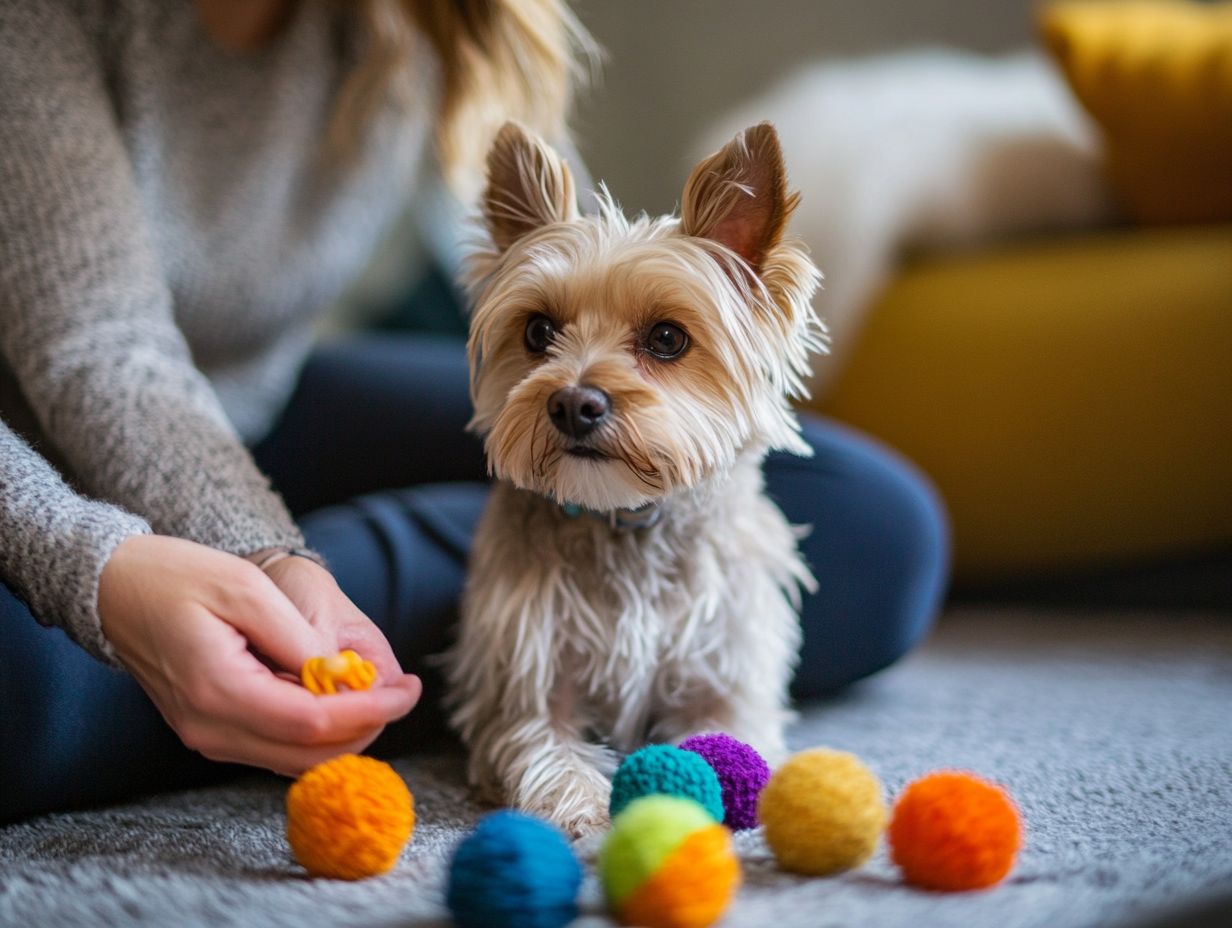
Add relaxation techniques to your training. They help manage your pet’s anxiety. These practices create a calming presence and enable effective behavior modification.
Integrating methods like deep pressure therapy gently pressing on specific spots on your pet’s body can soothe nervous animals during tough times. Soothing music can help lower stress and create a calm atmosphere for better focus during training.
These techniques not only enhance the learning experience but also promote emotional well-being. This makes it easier for pets to adapt to new environments and stimuli. By fostering a supportive atmosphere, you build trust and encourage a healthier relationship between pets and their owners.
Consulting with a Professional for Severe Cases
In severe instances of pet anxiety, consult with professionals. This creates a tailored treatment plan that makes a real difference for your pet!
By doing so, you ensure proper safety assessments and comprehensive dog training strategies are implemented.
When to Seek Help and What to Expect
Knowing when to seek help for your pet’s anxiety is crucial. Pay attention when anxiety signs start affecting their quality of life. At that point, professional support is a necessary option.
As a pet owner, be vigilant about specific behaviors like excessive barking, hiding, or destructive tendencies. These may indicate deeper emotional distress. During a consultation, expect a thorough behavioral assessment. This allows the veterinarian or animal behaviorist to evaluate your furry companion s symptoms.
The assessment typically involves discussing your pet’s daily routines, identifying anxiety triggers, and exploring past experiences that might contribute to their current state. Based on this evaluation, a personalized treatment plan might be recommended, including behavioral therapy, medications, or suggestions for environmental adjustments to reduce anxiety and enhance well-being.
Frequently Asked Questions
What is play therapy for anxious pets?
Play therapy for anxious pets uses playful activities to help reduce anxiety and improve behavior. It involves using toys, games, and interactive techniques to help pets learn new coping skills and bond with their owners. For more insights, check out what to know about therapy for anxious pets.
How does play therapy benefit anxious pets?
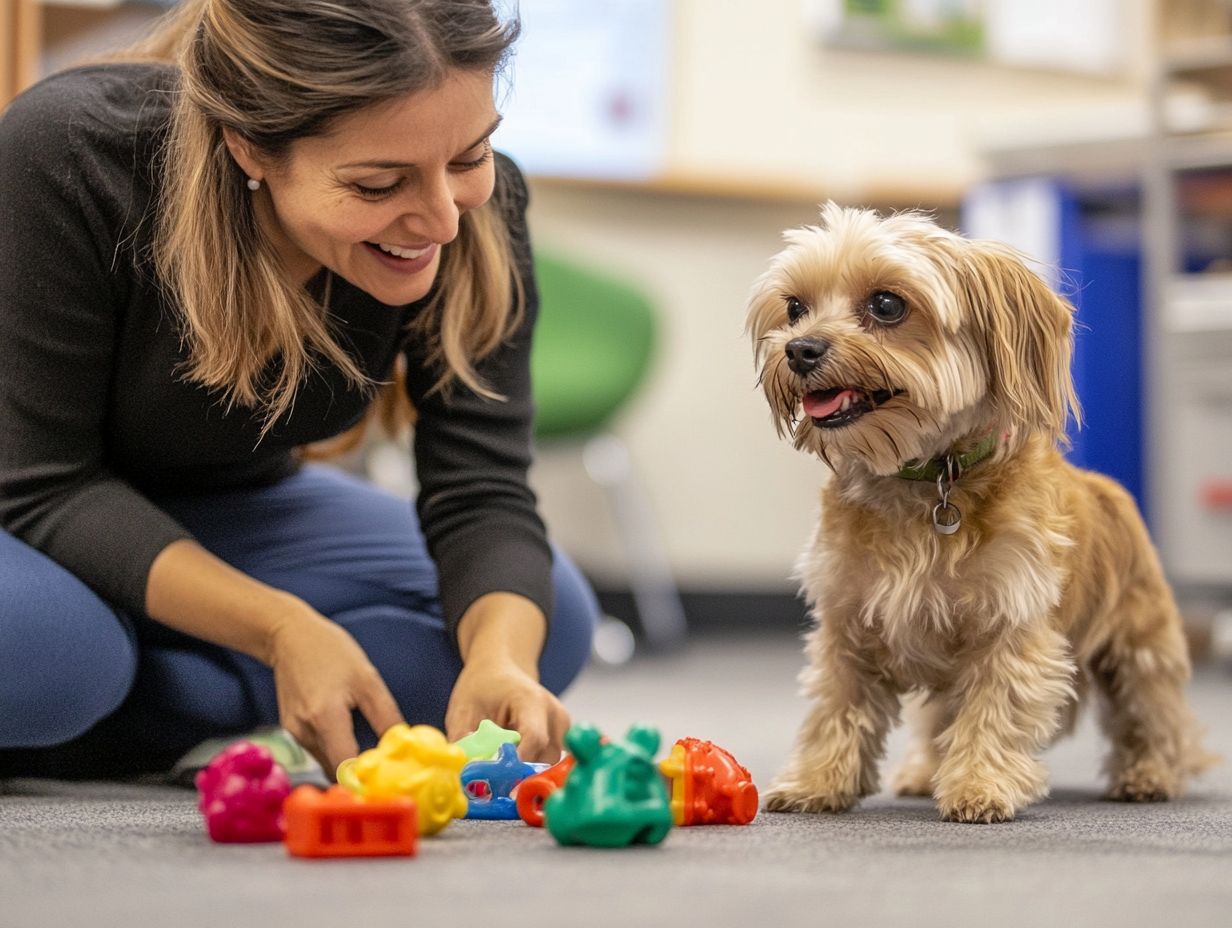
Play therapy can benefit anxious pets by helping them release pent-up energy, improve problem-solving skills, and reduce stress. Additionally, understanding the role of outdoor play in pet anxiety can boost their confidence and strengthen the bond with their owner.
What types of activities are involved in play therapy for anxious pets?
Activities used in play therapy can include chasing games, puzzle toys, and interactive play with their owner. These are tailored to meet the specific needs and preferences of the pet.
How do I know if my pet would benefit from play therapy?
If your pet shows signs of anxiety like destructive behavior, excessive barking, or avoidance behavior, they may benefit from play therapy. Consulting a professional can help you understand the anxiety spectrum in pets and determine if this therapy is right for your pet.
Is play therapy suitable for all types of pets?
Play therapy can benefit various pets, including cats, dogs, and small animals like rabbits and guinea pigs. However, consult with a professional to check if it’s suitable for your specific pet.
How can I find a qualified play therapist for my anxious pet?
Ask your veterinarian for recommendations or research online to find a certified pet play therapist. Be sure to inquire about their experience and credentials before making your decision.
Taking the first step towards helping your anxious pet can make all the difference. Don’t wait start today!

